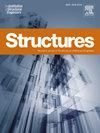Experimental and numerical investigation on flexural performance of non-prestressed concrete precast bottom slab with a removable section steel and three ribs
IF 4.3
2区 工程技术
Q1 ENGINEERING, CIVIL
引用次数: 0
Abstract
Current methods for enhancing the bending stiffness of non-prestressed concrete precast bottom slabs are constrained by the limited height of reinforcing elements, restricting their use to spans of up to 3.6 m. This study introduces the NPS-3R, an innovative precast bottom slab design that incorporates precast concrete segmental ribs and removable section steel. The design tackles common challenges such as insufficient bending stiffness and the reliance on temporary supports in large-span non-prestressed concrete precast bottom slabs (NLBS). To evaluate the bending behavior of the NPS-3R design, three full-scale precast bottom slab specimens were fabricated and subjected to static loading tests. These tests were complemented by detailed finite element (FE) simulations to analyze the stress distribution, deformation characteristics, and the interaction between the section steel and segmental ribs, providing a comprehensive understanding of the slab's flexural performance under varying loading conditions. Experimental results reveal a notable enhancement in flexural performance, with the cracking load and ultimate bearing capacity increasing by 78.9 % and 72.6 %, respectively, compared to NLBS. Although the addition of steel trusses has a limited effect on the overall bending behavior of NPS-3R, contributing only an 8.1 % increase in cracking load and a 3.9 % increase in ultimate load capacity, it significantly influences late-stage bending stiffness. The numerical model developed in this study shows high reliability, with stiffness errors in the load-mid-span deflection curves remaining below 10 % compared to experimental values. Simulation results further reveal that the length of short ribs, the section steel, and the diameter of stressed reinforcement are key factors affecting NPS-3R's bending performance. Additionally, the improved bending stiffness calculation method, based on integral and superposition techniques, demonstrates high accuracy and provides a reference for engineering design. These findings offer valuable insights for the design and optimization of precast concrete structures, providing a promising solution for improving the performance of large-span bottom slabs in both practical applications and theoretical research.
无预应力混凝土三肋可拆型钢预制底板抗弯性能试验与数值研究
目前用于提高非预应力混凝土预制底板抗弯刚度的方法受到增强元件高度的限制,限制了它们的使用跨度高达3.6 m。本研究介绍了NPS-3R,一种创新的预制底板设计,结合了预制混凝土节段肋和可拆卸截面钢。该设计解决了诸如大跨度非预应力混凝土预制板(NLBS)中抗弯刚度不足和依赖临时支撑等常见挑战。为了评估NPS-3R设计的弯曲性能,制作了三个全尺寸预制底板试件并进行了静载试验。这些试验辅以详细的有限元模拟,以分析应力分布、变形特征以及型钢与节段肋之间的相互作用,从而全面了解不同荷载条件下的板的抗弯性能。试验结果表明,与NLBS相比,其抗弯性能得到了显著提高,开裂荷载和极限承载力分别提高了78.9% %和72.6 %。尽管钢桁架的加入对NPS-3R的整体弯曲性能影响有限,仅增加了8.1 %的开裂载荷和3.9 %的极限承载能力,但它对后期抗弯刚度有显著影响。本研究建立的数值模型具有较高的可靠性,与试验值相比,荷载-跨中挠度曲线的刚度误差保持在10 %以下。仿真结果进一步表明,短肋长度、截面型钢和受应力钢筋直径是影响NPS-3R抗弯性能的关键因素。此外,基于积分和叠加技术的改进抗弯刚度计算方法具有较高的精度,可为工程设计提供参考。这些发现为预制混凝土结构的设计和优化提供了有价值的见解,为提高大跨度底板的实际应用和理论研究提供了有希望的解决方案。
本文章由计算机程序翻译,如有差异,请以英文原文为准。
求助全文
约1分钟内获得全文
求助全文
来源期刊

Structures
Engineering-Architecture
CiteScore
5.70
自引率
17.10%
发文量
1187
期刊介绍:
Structures aims to publish internationally-leading research across the full breadth of structural engineering. Papers for Structures are particularly welcome in which high-quality research will benefit from wide readership of academics and practitioners such that not only high citation rates but also tangible industrial-related pathways to impact are achieved.
 求助内容:
求助内容: 应助结果提醒方式:
应助结果提醒方式:


